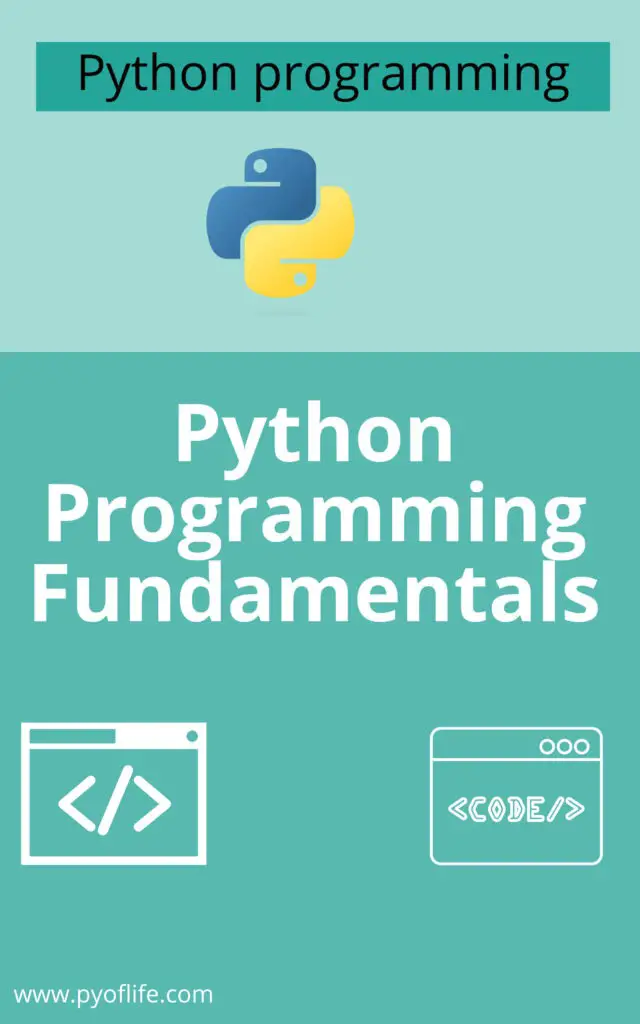Python Programming Fundamentals: Python is a versatile and popular programming language known for its simplicity and readability. It has gained immense popularity in various domains, including web development, data analysis, artificial intelligence, and automation. Whether you are a beginner or an experienced programmer, understanding the fundamentals of Python is essential to harness its full potential. In this article, we will explore the key concepts and principles that form the foundation of Python programming.
1. Introduction to Python
Python is a high-level, interpreted programming language developed by Guido van Rossum in the late 1980s. It emphasizes code readability and allows programmers to express concepts in fewer lines of code compared to other languages. Python’s design philosophy focuses on simplicity and clarity, making it an excellent choice for beginners.

2. Variables and Data Types
In Python, variables are used to store data. They can hold different types of values, such as numbers, strings, lists, and dictionaries. Python supports various data types, including integers, floats, strings, booleans, lists, tuples, and dictionaries. Understanding data types is crucial for manipulating and organizing data effectively.
3. Control Structures
3.1 Conditional Statements
Conditional statements in Python allow us to execute different blocks of code based on specific conditions. The if, elif, and else statements are used to perform conditional branching. By utilizing these statements, programmers can make their programs more flexible and responsive to different scenarios.
3.2 Loops
Loops are used to repeatedly execute a block of code until a specific condition is met. Python provides two types of loops: for loop and while loop. These loops are invaluable when it comes to iterating over elements in a list, performing repetitive tasks, or implementing algorithms.
4. Functions and Modules
Functions are reusable blocks of code that perform specific tasks. They allow programmers to break down complex problems into smaller, manageable parts. Python also supports modules, which are files containing Python code that can be imported into other programs. Modules provide a way to organize and reuse code across different projects.
5. File Handling
File handling is an essential aspect of programming that involves reading from and writing to files. Python provides various functions and methods to interact with files, allowing programmers to perform operations such as reading data from a file, writing data to a file, and modifying existing files.
6. Exception Handling
Exception handling enables programmers to handle and recover from errors or exceptional situations that may occur during program execution. Python’s exception-handling mechanism helps prevent program crashes and allows for graceful error handling and recovery.
7. Object-Oriented Programming (OOP)
Python is an object-oriented programming (OOP) language. It supports the concepts of classes and objects, inheritance, and polymorphism. OOP allows programmers to create reusable and modular code, making it easier to manage complex projects and collaborate with other developers.
7.1 Classes and Objects
Classes are blueprints or templates for creating objects. Objects are instances of classes that encapsulate data and behavior. By using classes and objects, programmers can model real-world entities and implement complex systems with ease.
7.2 Inheritance
Inheritance is a fundamental concept in OOP that allows classes to inherit attributes and methods from other classes. It promotes code reuse, extensibility, and modular design. In Python, classes can inherit from one or more base classes, forming a hierarchy of classes.
7.3 Polymorphism
Polymorphism allows objects of different classes to be treated as objects of a common base class. It enables flexibility and dynamic behavior in code. Polymorphism is achieved through method overriding and method overloading in Python.
8. Python Libraries and Frameworks
Python offers a vast ecosystem of libraries and frameworks that extend its capabilities and provide solutions for specific tasks. Some popular libraries include NumPy for scientific computing, pandas for data analysis, matplotlib for data visualization, and Flask and Django for web development. Leveraging these libraries and frameworks can significantly enhance productivity and efficiency.
9. Best Practices and Tips
To write clean, maintainable, and efficient Python code, it is essential to follow best practices. Some tips include writing modular and reusable code, using meaningful variable and function names, adhering to PEP 8 style guidelines, and documenting code effectively. By adopting these practices, developers can improve code quality and collaboration.
10. Conclusion
Python’s simplicity, versatility, and robustness have made it a preferred programming language for beginners and professionals alike. In this article, we explored the fundamentals of Python programming, including variables, control structures, functions, file handling, exception handling, object-oriented programming, and Python libraries. By mastering these concepts, you can unlock endless possibilities and embark on exciting software development journeys.
11. FAQs (Frequently Asked Questions)
Q1: Can I use Python for web development? A: Yes, Python can be used for web development. Frameworks like Django and Flask provide powerful tools and functionalities for building web applications.
Q2: Is Python suitable for scientific computing? A: Absolutely. Python, along with libraries like NumPy, SciPy, and pandas, is widely used for scientific computing, data analysis, and machine learning.
Q3: Are Python programs cross-platform compatible? A: Yes, Python programs can run on various platforms, including Windows, macOS, and Linux, without any major modifications.
Q4: Can I contribute to the Python community? A: Yes, Python is an open-source language, and you can contribute to its development by submitting bug reports, proposing enhancements, or contributing to the core Python codebase.
Q5: Where can I find additional resources to learn Python? A: There are numerous online tutorials, documentation, and books available to learn Python. Websites like Python.org and online learning platforms like Coursera and Udemy offer comprehensive Python courses.
In conclusion, Python’s simplicity, readability, and extensive ecosystem make it an excellent choice for programming beginners and seasoned developers. By mastering the fundamentals of Python, you can embark on exciting projects, solve real-world problems, and contribute to the thriving Python community.
Thank you ever so for you post.Really thank you! Fantastic.
I really like and appreciate your post. Will read on…